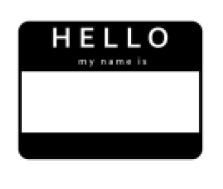 Rule #1. Good data in, equals good data out . . . New vision applications at RR Floody commence with a documented application evaluation process. This process is based on decades of machine vision experience, and we truly feel it is not only the correct way to approach machine vision; but the only way. With successful machine vision implementation, it is necessary to acquire an understanding of the products to be inspected and defects to be rejected. Having the best data at the beginning of your vision application will yield the best opportunity for success. Obtaining good data requires time, commitment, and strict discipline. In the production environment, defects can and will vary widely. Anyone can have success in identifying major defects, but the minor ones often require inspection tools to be tested on hundreds, or even thousands of images. There is a fine and costly line between catching necessary minor defects and falsely rejecting acceptable product.
Rule #1. Good data in, equals good data out . . . New vision applications at RR Floody commence with a documented application evaluation process. This process is based on decades of machine vision experience, and we truly feel it is not only the correct way to approach machine vision; but the only way. With successful machine vision implementation, it is necessary to acquire an understanding of the products to be inspected and defects to be rejected. Having the best data at the beginning of your vision application will yield the best opportunity for success. Obtaining good data requires time, commitment, and strict discipline. In the production environment, defects can and will vary widely. Anyone can have success in identifying major defects, but the minor ones often require inspection tools to be tested on hundreds, or even thousands of images. There is a fine and costly line between catching necessary minor defects and falsely rejecting acceptable product.
Our best advice is to make certain that you and/or your vision vendor take the extra time necessary to acquire good information up front. Additionally, a thorough study of the product matrix that will pass through a vision system is always necessary. Take time to comb for “gotch-ya’s”. A common one that we see is large products in-line with small products, which opens the field of view, decreasing resolution available for detailed inspection.
 Rule #2. Make certain you are programming from a “Golden Image”. . . It is imperative that a vision system is programmed using a “golden image”. Often during production line startups, product measurements can vary as products are brought up to constant operating temperature. Make certain you take the time to verify that your trained product is within your identified specifications. Failure to complete this rule will diminish consistency in your results.
Rule #2. Make certain you are programming from a “Golden Image”. . . It is imperative that a vision system is programmed using a “golden image”. Often during production line startups, product measurements can vary as products are brought up to constant operating temperature. Make certain you take the time to verify that your trained product is within your identified specifications. Failure to complete this rule will diminish consistency in your results.
 Rule #3. Accurately name your inspection tools and machine vision components. . . Tools can receive names by default. Additionally, if you copy a tool over it may my only receive an additional numerical prefix/suffix to differentiate it from the original tool. This can create confusion as more complex inspections can requiring many dependent tools. Even the simplest changes can make a big difference. Accurately naming tools and components of machine vision can also be very important for support or transfer of project ownership to other team members.
Rule #3. Accurately name your inspection tools and machine vision components. . . Tools can receive names by default. Additionally, if you copy a tool over it may my only receive an additional numerical prefix/suffix to differentiate it from the original tool. This can create confusion as more complex inspections can requiring many dependent tools. Even the simplest changes can make a big difference. Accurately naming tools and components of machine vision can also be very important for support or transfer of project ownership to other team members.
 Rule #4 Check your work . . . Take your time in machine vision implementation. Make certain you have all your preliminary information correct. You can think of a machine vision application somewhat like building a home. Would you have a desire to live in a house that was never inspected at its vital stages (framing, electrical, plumbing, etc.)? You would be living in a ticking time bomb, just waiting for something to go wrong. Please don’t make your vision application a ticking time bomb. Your time invested upfront and throughout will pay dividends down the road. Set a goal for yourself to scan through a log of images when you implement new tools. Make certain you have defect samples and they are failing when they are supposed to. Don’t forget to check good samples as well, to make certain you retain acceptable production yields.
Rule #4 Check your work . . . Take your time in machine vision implementation. Make certain you have all your preliminary information correct. You can think of a machine vision application somewhat like building a home. Would you have a desire to live in a house that was never inspected at its vital stages (framing, electrical, plumbing, etc.)? You would be living in a ticking time bomb, just waiting for something to go wrong. Please don’t make your vision application a ticking time bomb. Your time invested upfront and throughout will pay dividends down the road. Set a goal for yourself to scan through a log of images when you implement new tools. Make certain you have defect samples and they are failing when they are supposed to. Don’t forget to check good samples as well, to make certain you retain acceptable production yields.
 Rule #5 When in doubt, consult an expert . . . (RR Floody) If you get into trouble on any vision application it is important to have a reliable, easily accessible expert. RR Floody boasts over 80 years of combined vision system experience, and we pride ourselves on our partnerships with our customers. We also have an extensive vision lab with thousands of vision system components (cameras, lights, lens, filters, ect). Contact us when evaluating a new project or refining an existing one, or vision lab is a free resource to our customers. We encourage our customers to limit time spent on troubleshooting issues. We have seen customers struggle for hours and then a fresh set of eyes evaluates the situation and resolves the dilemma in minutes.
Rule #5 When in doubt, consult an expert . . . (RR Floody) If you get into trouble on any vision application it is important to have a reliable, easily accessible expert. RR Floody boasts over 80 years of combined vision system experience, and we pride ourselves on our partnerships with our customers. We also have an extensive vision lab with thousands of vision system components (cameras, lights, lens, filters, ect). Contact us when evaluating a new project or refining an existing one, or vision lab is a free resource to our customers. We encourage our customers to limit time spent on troubleshooting issues. We have seen customers struggle for hours and then a fresh set of eyes evaluates the situation and resolves the dilemma in minutes.
 Rule #6 No Fear! . . . This may seem contradictive to the statement above, but we encourage all vision system engineers, expert, or novice, to push themselves outside of their comfort zone to foster continued growth and confidence.
Rule #6 No Fear! . . . This may seem contradictive to the statement above, but we encourage all vision system engineers, expert, or novice, to push themselves outside of their comfort zone to foster continued growth and confidence.

Good Luck with your vision application . . . and remember we are only a phone call or email away!